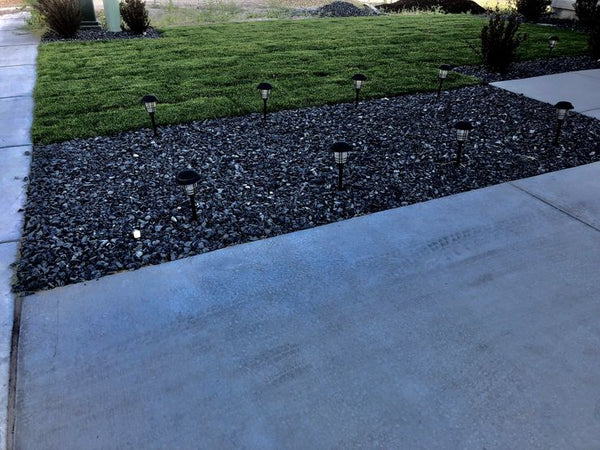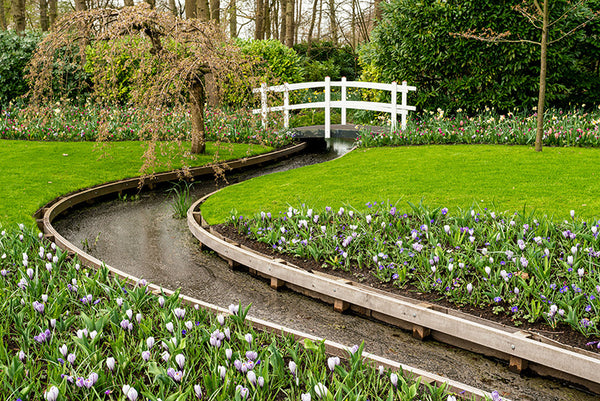How do I calculate how much rock, mulch, topsoil I need?
This is a question that we often get asked. The answer is always that you need to measure the area. But then what? The calculation can be fairly easy once you break it down into steps.
Method 1: Standard Cubic Yard Formula:
(Length (in feet) x Width (in feet) x Depth (in inches) divided by 12 divided by 27 = Cubic Yards
Step 1: Determine the Square Footage.
This is done by measuring the length and width the area which you need material. You would want this measurement rounded up to the nearest foot or 1/2 foot. Then you would multiply those measurements together. i.e. 10 ft length x 20 ft width = 200 Square Feet. If there is more than 1 area, you would want to measure each one separate.
Step 2. Decide on what depth you will be placing the material.
The depth seems to be the trickiest part for most people. This is especially true when dealing with rock. But there is a rule of thumb that helps you out here. The rule of thumb is that the minimum depth should be twice the size of the rock. This will give you atleast 2 full layers of rock preventing seeing the bare ground underneath. So if the rock is 1 1/2" then 1.5 x 2 = 3 inches. 3 inches deep in this case would be the minimum amount of depth that you would want to calculate with. If the rock size is 2" then 4 inches would be your minimum depth that you would want to use.
What if you are dealing with a rock that has a size range or multiple sizes such as a rock that ranges between 2" and 6 inches in size? The answer would be to pick the average of the range and multiply that by 2. So the midpoint between 2" and 6" would be 8". 8 inches would be the depth.
Remember no matter how hard we try, we cannot place a 3" - 4" rock 2 inches deep. It just won't work out and we shouldn't calculate a 2" depth with a 3" - 4" rock either. You will run short every time.
Step 3. Back to the calculation
Now that you determined your square footage and picked your depth. We can take the total square footage (in feet) and multiply it by the depth (in inches) lets use 3" for this example.
If we have that 10 ft x 20 ft area (200 Square Feet) used above x 3 = 600. Now take 600 and divide by 12. This will give us 50. This number is actually how many cubic feet we have to fill.
Step 4: Convert to Cubic Yards.
Take the Cubic Feet number we determined above (50) and divide that by 27. There are 27 cubic feet in a cubic yard. 50 divided by 27 = 1.85. Round that up to the nearest 1/2.
You would need 2 cubic yards to fill an area 10 ft x 20 ft x 3 inches deep.
Method 2: Calculate by taking the square footage and dividing by the coverage amount at each depth.
This method will give you a slightly larger number than the cubic yard formula. But its better to have a little extra than to run short.
Coverage per cubic yard:
1" deep = 300 Square Feet
2" deep = 150 Square Feet
3" deep = 100 Square Feet
4" deep = 75 Square Feet
5" deep = 60 Square Feet
6" deep = 50 Square Feet
7" deep = 42 Square Feet
8" deep = 37 Square Feet
I personally like this method as for me it is faster and most of my measurements don't require depths over 8".
Step 1: Determine Square Footage. As we learned above we measure our area Length (in feet) and Width (in feet).
Lets take the same square footage measurement that we used above.
10 ft x 20 ft = 200 Square Feet.
Step 2: Decide on your depth. Lets use the 3" depth like we used above.
Step 3. Divide Square Footage by Coverage per cubic yard at chosen depth.
200 divided by 100 = 2. You would need 2 cubic yards to fill the space.
This method is quick and easy with less steps and numbers to remember.
The key to determining how much material you will need on your project is to measure.
Note: Now not all areas are perfectly square, but when calculating your measurements round up, if it curves in and out, pick an average between the distances or use the higher number. You can usually utilize some extra, but its hard to make material stretch without thinning out too much.
Frequently asked questions
Q: What if the area is a triangle?
Measure it as a square a divide in half. 1/2 of a rectangle or square is a triangle.
What if the area is a circle?
Pi R Squared.
Pi = 3.1415 or round up to 3.15 it won't hurt any rounding up. Rounding down does risk running short, although round down to 3.14 probably wont hurt any either.
R = Radius.
Radius = Half of the diameter
Diameter = length across the circle
Squared = multiplying the number by itself. In this measurement we square just the Radius. Not Pi x R.
Lets say we have a 16 ft circle.
Pi R Squared
3.15 x 8 x 8 = 201.6
201.6 would be the square footage of a 16 ft circle
Now you could use either method to determine cubic yards needed.
What if the product I am getting is sold by weight (Tons) and not Volume (Cubic Yards)
To solve this you need to know the density (weight per cubic yard). if you know the weight per cubic foot you can multiply that number by 27 to get weight per cubic yard.
Most rocks and material in our area of Salt Lake City and Utah tend to weigh in between 2400 - 3000 lbs per cubic yard. 1.2 tons - 1.5 tons per cubic yard. But every material can weigh differently.
If the material weighs 1.5 tons per cubic yard and you need 2 cubic yards, you would need 3 tons of that material.
Other issues that could affect measurements would be compaction. If you are using a material that needs to be compacted such as paver base, road base, paver sand, chat, decomposed granite, etc. These materials tend to compact and depending on your method of compaction you could see 15% - 30% compaction. Many variables will affect this and this amount won't be calculated in the initial measurements so you would likely need to take your amount and increase it by between 15% and 30% to insure enough material is being ordered.
Now you know how to determine the amount of material that you need using 2 different methods. There are other methods, but I like these ones the best. Hopefully it helps you out too.



